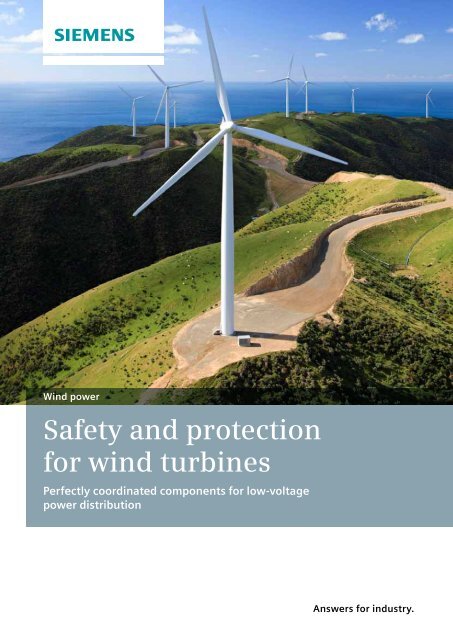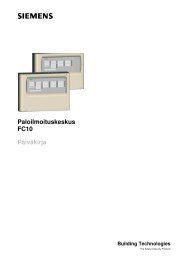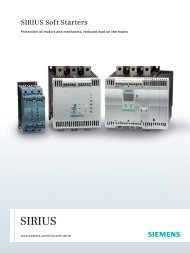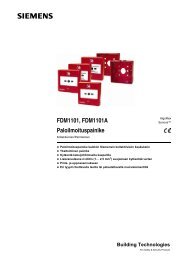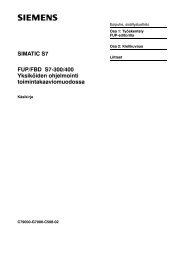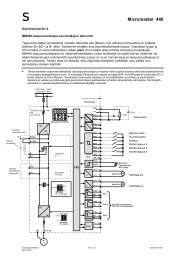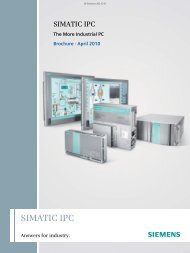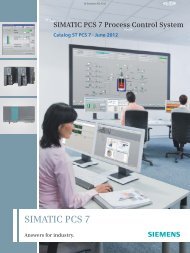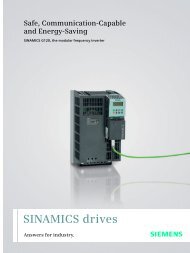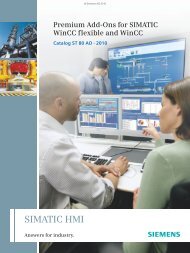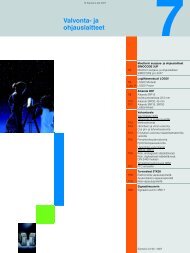Safety and protection for wind turbines - Siemens
Safety and protection for wind turbines - Siemens
Safety and protection for wind turbines - Siemens
You also want an ePaper? Increase the reach of your titles
YUMPU automatically turns print PDFs into web optimized ePapers that Google loves.
s<br />
Wind power<br />
<strong>Safety</strong> <strong>and</strong> <strong>protection</strong><br />
<strong>for</strong> <strong>wind</strong> <strong>turbines</strong><br />
Perfectly coordinated components <strong>for</strong> low-voltage<br />
power distribution<br />
Answers <strong>for</strong> industry.
Main circuit<br />
Auxiliary<br />
circuit
Additional<br />
system<br />
components
Contents<br />
Safe <strong>and</strong> efficient use of <strong>wind</strong> power 06 – 07<br />
Components <strong>for</strong> the main circuit 08 – 12<br />
Components <strong>for</strong> the auxiliary circuits 13 – 21<br />
Additional system components 22 – 27<br />
Comprehensive <strong>and</strong> competent product offering 28<br />
Any questions One click – well-in<strong>for</strong>med 29<br />
4
Reliable power supply<br />
<strong>and</strong> distribution<br />
Wind <strong>turbines</strong> do not only generate electricity – they<br />
are also dependent on both a reliable supply of electrical<br />
power <strong>and</strong> on its safe <strong>and</strong> economical distribution. An<br />
additional high priority is the <strong>protection</strong> of both people<br />
<strong>and</strong> electrical equipment. We offer you products, systems<br />
<strong>and</strong> a comprehensive <strong>protection</strong> concept <strong>for</strong> optimal power<br />
distribution in <strong>wind</strong> <strong>turbines</strong>, thus ensuring that you are<br />
always in safe h<strong>and</strong>s.<br />
5
Safe <strong>and</strong> efficient use of <strong>wind</strong> power<br />
Wind is one of the oldest <strong>for</strong>ms of energy.<br />
People have been using the potential of <strong>wind</strong><br />
power to drive machinery <strong>for</strong> thous<strong>and</strong>s of<br />
years. Following the discovery of electricity<br />
<strong>and</strong> the invention of the generator, the idea of<br />
using <strong>wind</strong> power to generate electricity was<br />
quite literally hanging in the air. Nowadays,<br />
<strong>wind</strong> <strong>turbines</strong> of all different sizes <strong>and</strong> at the<br />
most varied of locations convert the kinetic<br />
energy of an air flow into electrical power.<br />
Wind power is playing an increasingly important<br />
role worldwide, due primarily to the fact<br />
that it is extremely environmentally friendly –<br />
because it is CO 2 -neutral – <strong>and</strong>, unlike fossil<br />
fuels, there is an unlimited supply available.<br />
Protecting, switching, measuring <strong>and</strong> monitoring<br />
are the basic functions of a low-voltage<br />
power distribution system in <strong>wind</strong> <strong>turbines</strong>.<br />
In this segment <strong>and</strong> in many others, the name<br />
<strong>Siemens</strong> has been synonymous with innovation,<br />
outst<strong>and</strong>ing technology <strong>and</strong> a reliable<br />
partner <strong>for</strong> many years. Customers around<br />
the world rely on our extensive product <strong>and</strong><br />
system portfolio. You too can enjoy the<br />
benefits of maximum safety <strong>and</strong> optimal<br />
functionality!<br />
6
Distributing power<br />
intelligently <strong>and</strong> safely<br />
Principle of operation<br />
A <strong>wind</strong> turbine consists of a rotor, a nacelle<br />
with machinery <strong>and</strong> a generator which can<br />
be connected to an upstream gearbox, a<br />
converter <strong>and</strong> a tower. Effective monitoring<br />
<strong>and</strong> control technology is essential,<br />
since the operating parameters must be<br />
constantly adapted to the prevailing <strong>wind</strong><br />
conditions. Each <strong>and</strong> every <strong>wind</strong> turbine is<br />
dependent on a reliable electrical power<br />
supply, since this is the basic prerequisite<br />
<strong>for</strong> every control system.<br />
Particular challenges<br />
The output from a <strong>wind</strong> turbine can change<br />
rapidly <strong>and</strong> unpredictably depending on<br />
the strength <strong>and</strong> direction of the <strong>wind</strong>.<br />
There are also constant mechanical <strong>and</strong><br />
climatic stresses, in particular changing<br />
<strong>wind</strong> loads, low-frequency vibrations <strong>and</strong><br />
differences in temperature ranging between<br />
-40 <strong>and</strong> +70 °C. Equally, the frequent<br />
connection <strong>and</strong> disconnection of the <strong>wind</strong><br />
turbine can result in the thermal loading of<br />
live components.<br />
Perfectly coordinated components<br />
To reliably maintain the functional capability<br />
<strong>and</strong> availability of the <strong>protection</strong><br />
devices under these circumstances, components<br />
must be used which have a safe<br />
range that is matched to the requirements<br />
of the <strong>wind</strong> turbine. Our SENTRON <strong>protection</strong>,<br />
switching, measuring <strong>and</strong> monitoring<br />
devices with optional communication<br />
modules provide the ideal solution.<br />
Comprehensive portfolio worldwide<br />
We can offer you an extensive portfolio of<br />
low-voltage power distribution components.<br />
The consistency, modularity <strong>and</strong> reliable<br />
interaction of our components <strong>and</strong> systems<br />
offer you numerous advantages – throughout<br />
their service life <strong>and</strong> wherever you are<br />
in the world.<br />
Read the QR code<br />
with your QR code<br />
reader.<br />
Highlights<br />
Safe power supply <strong>and</strong> distribution<br />
thanks to coordinated<br />
components<br />
A high level of <strong>protection</strong> thanks<br />
to first-class <strong>protection</strong>, switching,<br />
measuring <strong>and</strong> monitoring<br />
devices<br />
A high level of cost effectiveness<br />
thanks to intelligent, modular<br />
<strong>and</strong> integrated components<br />
Increasing per<strong>for</strong>mance capacity <strong>and</strong> costs – higher risk<br />
Rotor diameter<br />
Increase in capacity:<br />
In just 20 years, the yield from<br />
<strong>wind</strong> <strong>turbines</strong> has increased<br />
50-fold. With the current 6 MW<br />
<strong>turbines</strong> <strong>and</strong> the 10-15 MW<br />
<strong>turbines</strong> which are already in the<br />
development phase, this yield will<br />
again increase many times over.<br />
Hub height<br />
1990 2012<br />
Rated power<br />
Rotor diameter<br />
Hub height<br />
Annual yield<br />
250 kW<br />
30 m<br />
50 m<br />
400,000 kWh<br />
1,500 kW<br />
70 m<br />
100 m<br />
3,500,000 kWh<br />
3,000 kW<br />
90 m<br />
105 m<br />
6,900,000 kWh<br />
6,000 kW<br />
126 m<br />
135 m<br />
approx. 20,000,000 kWh<br />
7
The main circuit is responsible <strong>for</strong><br />
the basic function of a <strong>wind</strong> turbine,<br />
i. e. the generation of electric power<br />
<strong>and</strong> the grid-compliant infeed of<br />
this power into the network.<br />
Safe power distribution in<br />
the main circuit<br />
Highlights<br />
Main circuit:<br />
overview<br />
Comprehensive product portfolio<br />
<strong>for</strong> safe power distribution<br />
in the main circuit<br />
Maximum availability of the<br />
<strong>wind</strong> turbine thanks to high<br />
product quality<br />
Coordinated products satisfy<br />
requirements even under<br />
extreme conditions<br />
Reliable components support<br />
grid-compliant power quality<br />
Grid-compliant power generation<br />
The main circuit in a <strong>wind</strong> turbine is<br />
responsible <strong>for</strong> power generation via the<br />
generator <strong>and</strong> the transmission of power<br />
up to the infeed into the grid. The <strong>wind</strong><br />
powers the generator via the rotor. This<br />
generates a voltage with a variable frequency.<br />
Behind the generator, a converter<br />
is there<strong>for</strong>e connected to a DC link. This DC<br />
link first converts the variable AC voltage<br />
into a direct voltage, be<strong>for</strong>e converting it<br />
back into an AC voltage with a constant<br />
power supply frequency <strong>and</strong> voltage (e. g.<br />
50Hz/690V). This way, the <strong>wind</strong> turbine<br />
can produce grid-compliant power from<br />
highly variable <strong>wind</strong> speeds. The turbine<br />
control system constantly monitors <strong>and</strong><br />
adapts the turbine parameters in order<br />
to ensure compliance with the required<br />
infeed parameters.<br />
High stress<br />
This constant adaptation process results in<br />
the frequent switching of the electrical<br />
equipment <strong>and</strong> the constant optimization<br />
of the operating parameters by the control<br />
system. When disconnecting <strong>and</strong> reconnecting<br />
the generator power to the network,<br />
currents of up to several thous<strong>and</strong> A<br />
must be managed, which leads to extreme<br />
stress on the electrical equipment.<br />
Our range of products <strong>for</strong> the main circuit<br />
Our coordinated product portfolio – from<br />
SIVACON busbar trunking systems to 3WL<br />
air circuit breakers <strong>and</strong> SITOR semiconductor<br />
fuses – ensures the safe, consistent <strong>and</strong><br />
efficient distribution of the generated<br />
power in the main circuit.<br />
Grid-compliant power quality<br />
Given the increasing proportion of <strong>wind</strong><br />
<strong>turbines</strong> in the overall energy mix, it is<br />
essential that they contribute to the stability<br />
of the grid. The specifications <strong>for</strong> this<br />
are defined in national Grid Codes. The<br />
operational management of the <strong>wind</strong> turbine<br />
required <strong>for</strong> a corresponding reactivepower<br />
supply <strong>and</strong> <strong>for</strong> the stabilization of<br />
the public grid results in increased requirements<br />
with regard to the regulation algorithms<br />
of the power semiconductors <strong>and</strong><br />
switching devices in the main circuit.<br />
8
Reliable conveyance of the<br />
generated power<br />
Safe transmission of high currents<br />
High power outputs must be distributed<br />
<strong>and</strong> transmitted in the <strong>wind</strong> turbine safely<br />
<strong>and</strong> with as little loss as possible. This can<br />
be achieved by means of the LD system<br />
from the SIVACON 8PS busbar trunking<br />
system range which can be fitted both<br />
quickly <strong>and</strong> safely. It is ideally suited to<br />
the distribution <strong>and</strong> conveyance of power<br />
within the main circuit <strong>for</strong> a current range<br />
of 1,100 A to 5,000 A.<br />
Flexible power distribution<br />
The LD system is significantly superior to<br />
a conventional cable, especially <strong>for</strong> connecting<br />
the generator <strong>and</strong> converter in the<br />
nacelle, where space is often limited. The<br />
system is modular in design <strong>and</strong> offers safe<br />
connection conditions. Elbow units are<br />
also available, thus ensuring that difficult<br />
installation situations can be managed<br />
with ease. Use of this system offers significant<br />
benefits, particularly in relation to the<br />
connection of the nacelle to the power<br />
infeed in the base of the tower. Thanks to<br />
the enclosed design, the secure mounting<br />
to the tower <strong>and</strong> the corresponding contact<br />
connections, installation can be carried<br />
out in the production plant. This simplifies<br />
considerably the ef<strong>for</strong>t required <strong>for</strong> installation<br />
<strong>and</strong> commissioning.<br />
Reliable fire prevention<br />
The busbar also has an important function<br />
in regard to fire <strong>protection</strong>. It has a high<br />
thermal loading capacity with regard to the<br />
effects of a lightning strike. In accordance<br />
with VdS 3523, the fire load is reduced<br />
through use of a sheet steel enclosure <strong>and</strong><br />
the thin epoxy coating of the conductors.<br />
Additional safety is provided by the high<br />
short-circuit strength of the busbar trunking<br />
systems <strong>and</strong> the outgoing units. The<br />
ageing-resistant epoxy coating of the<br />
conductors offers additional <strong>protection</strong><br />
against water in the ventilated IP34 system<br />
(sprinkler-suitable) <strong>and</strong> the IP54 system.<br />
Reduction of EMC problems<br />
In comparison to an unshielded cable, the<br />
sheet steel enclosure of the busbar significantly<br />
reduces EMC-related interference.<br />
More in<strong>for</strong>mation<br />
www.siemens.com/lowvoltage/<br />
busbar-trunking-systems<br />
Main circuit:<br />
solutions<br />
Highlights<br />
Maximum short-circuit strength<br />
<strong>and</strong> much lower fire load compared<br />
to cables<br />
Pre-installation in the factory<br />
simplifies the on-site installation<br />
process<br />
Sheet steel enclosure to reduce<br />
EMC effects to a minimum<br />
The SIVACON 8PS busbar trunking system<br />
requires very little space <strong>and</strong> offers maximum<br />
safety <strong>and</strong> reliability.<br />
9
Switching <strong>and</strong> protecting<br />
the main circuit<br />
Highlights<br />
Main circuit:<br />
solutions<br />
Maximum system availability<br />
thanks to the rapid replacement<br />
of devices <strong>and</strong> preventive<br />
maintenance<br />
Simple diagnostics <strong>for</strong> the contact<br />
condition in order to determine<br />
the service intervals<br />
Voltage range 690 V +/- 20% to<br />
1,150 V <strong>and</strong> cold climate capability<br />
possible<br />
Externally controlled 3WL air<br />
circuit breaker <strong>for</strong> use with<br />
variable frequencies<br />
Effective <strong>protection</strong> of the main circuit<br />
The 3WL air circuit breaker protects the<br />
main circuit in the event of overload <strong>and</strong><br />
short circuit. It can be fitted with various<br />
electronic releases which enable the tripping<br />
characteristic to be optimally adapted<br />
to the conditions required. The connection<br />
between the generator <strong>and</strong> the converter,<br />
which has to contend with variable frequencies,<br />
is protected by the externally<br />
controlled 3WL air circuit breaker.<br />
Disconnection <strong>and</strong> maintenance<br />
The 3WL air circuit breaker is also used <strong>for</strong><br />
safe disconnection from the network when<br />
maintenance work is being carried out.<br />
Numerous locking options, e. g. a locking<br />
device to prevent unauthorized reconnection,<br />
guarantee maximum <strong>protection</strong> <strong>for</strong><br />
maintenance staff. Its diagnostics function<br />
supports preventive maintenance, e. g.<br />
through the replacement of worn main contacts.<br />
The optional withdrawable solution<br />
makes maintenance <strong>and</strong> repair work much<br />
easier, since the device can be replaced<br />
safely <strong>and</strong> easily if required, using the undetachable<br />
crank h<strong>and</strong>le.<br />
With consistent communication capability<br />
Thanks to the comprehensive range of<br />
communication options, the 3WL air circuit<br />
breaker can be optimally integrated into<br />
the <strong>wind</strong> turbine’s electronic management<br />
systems, thereby enabling all operating<br />
parameters to be detected in good time<br />
<strong>and</strong> ensuring that the necessary actions<br />
can be taken.<br />
Flexible in its range of applications<br />
A motorized operating mechanism enables<br />
the device to be switched back on remotely.<br />
All versions feature the modular design <strong>and</strong><br />
share the same complete range of st<strong>and</strong>ard<br />
accessories. Thanks to its very extensive<br />
operating temperature range of -25 to 70 °C<br />
<strong>and</strong> the storage temperature range of -40 to<br />
70 °C, it is ideally suited <strong>for</strong> use in <strong>wind</strong> <strong>turbines</strong><br />
under extreme climatic conditions.<br />
More in<strong>for</strong>mation<br />
www.siemens.com/lowvoltage/<br />
air-circuit-breakers<br />
Switching <strong>and</strong> protecting the main circuit<br />
Metering<br />
G<br />
Generator<br />
Power<br />
supply<br />
company<br />
St<strong>and</strong>ard-compliant power:<br />
The version with an increased voltage tolerance of 690V +/- 20% not only satisfies the fundamental<br />
LVRT-capability requirement, but also satisfies HVRT requirements <strong>for</strong> short-term voltage increases<br />
arising from regulations such as the German “BDEW – Technical guideline <strong>for</strong> generating plants<br />
connected to the medium-voltage network”.<br />
With three sizes, the 3WL air<br />
circuit breaker covers a range<br />
from 630 A to 6,300 A. The type<br />
rated 2,000 A is the smallest of<br />
its class.<br />
10
Effective <strong>protection</strong> concept<br />
<strong>for</strong> the converter<br />
Special <strong>protection</strong> required<br />
The sensitive power semiconductors of the<br />
converter react sensitively to short circuits<br />
<strong>and</strong> overload. In the event of uncontrolled<br />
failure due to extreme circumstances, this<br />
can result in considerable damage <strong>and</strong><br />
downtime <strong>for</strong> the entire <strong>wind</strong> turbine.<br />
High operational reliability<br />
A particularly fast protective device is required<br />
<strong>for</strong> <strong>protection</strong>. SITOR semiconductor<br />
fuses are the ideal solution <strong>for</strong> meeting<br />
these requirements as they are impervious<br />
to the variable frequencies on the generator<br />
side. Moreover, they have a high varying<br />
load factor which ensures a high level<br />
of operational reliability – even when subject<br />
to constant load change – <strong>and</strong>, thanks<br />
to their super-quick disconnect characteristic,<br />
offer much faster <strong>protection</strong> than all<br />
other <strong>protection</strong> devices.<br />
Increased system availability<br />
The optional fuse monitor signals the<br />
current condition to the <strong>wind</strong> turbine’s<br />
communication systems. This increases<br />
system transparency <strong>and</strong>, there<strong>for</strong>e,<br />
system availability.<br />
Simple planning, reliable operation<br />
SITOR semiconductor fuses are available in<br />
various designs <strong>for</strong> different per<strong>for</strong>mance<br />
classes <strong>and</strong> <strong>for</strong> a range of installation <strong>and</strong><br />
mounting requirements. They are clearly<br />
classified by operational class <strong>and</strong> in accordance<br />
with their function <strong>and</strong> are tested<br />
with regard to heat dissipation <strong>and</strong> maximum<br />
current loading, thereby simplifying<br />
the planning <strong>and</strong> dimensioning process.<br />
Possible damage is there<strong>for</strong>e prevented.<br />
More in<strong>for</strong>mation<br />
www.siemens.com/lowvoltage/<br />
fuse-systems<br />
Main circuit:<br />
solutions<br />
Highlights<br />
Effective <strong>protection</strong> of the sensitive<br />
power semiconductor with<br />
SITOR semiconductor fuses<br />
Super-quick disconnect characteristic<br />
of SITOR semiconductor<br />
fuses<br />
Increased system availability<br />
thanks to optional fuse<br />
monitoring<br />
Flexible installation thanks to a<br />
range of designs <strong>and</strong> mounting<br />
options<br />
Reliable <strong>protection</strong> of the power semiconductors in the converter<br />
DC<br />
AC<br />
Var. frequency<br />
AC<br />
Grid frequency<br />
to the generator<br />
to the grid<br />
SITOR semiconductor fuses<br />
reliably protect power semiconductors<br />
against the effects of a<br />
short circuit.<br />
Rectifier<br />
Converter<br />
Inverter<br />
11
Solutions <strong>for</strong> reactive-power<br />
compensation units<br />
Highlights<br />
Main circuit:<br />
solutions<br />
Full compliance with Grid Codes<br />
through reactive-power compensation<br />
Greater reliability of reactivepower<br />
compensation units<br />
through <strong>protection</strong> <strong>and</strong><br />
switching devices<br />
Intelligent control of the reactive-power<br />
compensation<br />
units through controllers<br />
Reliable disconnection in the<br />
event of dangerous network<br />
conditions<br />
Optimal power factor<br />
With certain system configurations, reactive-power<br />
compensation units must be<br />
provided in the main circuit of the <strong>wind</strong><br />
turbine in order to comply with requirements<br />
relating to the cos phi range, such<br />
as those defined in the Grid Codes.<br />
Protection of the compensation units<br />
NH fuse systems provide reactive-power<br />
compensation units with reliable <strong>protection</strong><br />
against short circuits. The fuse status<br />
can be queried remotely using the corresponding<br />
monitoring system.<br />
Rapid reactive-power compensation<br />
With the thyristor modules of the TSMLC<br />
<strong>and</strong> TSM-HV series, we offer the main<br />
components, the “electronic switch” <strong>for</strong><br />
dynamic power factor control units. Thanks<br />
to the robust technology of these components,<br />
they offer excellent reliability. The<br />
modules are wear-free, maintenance-free<br />
<strong>and</strong> self-monitoring.<br />
Conventional switching<br />
The 3RT16 capacitor contactors are specially<br />
designed <strong>for</strong> switching the capacitor<br />
modules. The capacitors are precharged by<br />
means of the mounted leading NO contacts<br />
<strong>and</strong> resistors – only then do the main contacts<br />
close. This prevents disturbances in<br />
the network <strong>and</strong> welding of the contactors,<br />
thereby protecting the contactors.<br />
Reliable capacitor technology<br />
Thanks to their long durability, the use of<br />
self-restoring capacitors offers maximum<br />
safety <strong>and</strong> reliability.<br />
High power factor through controllers<br />
The controllers <strong>for</strong> reactive-power compensation<br />
units are of the utmost importance<br />
<strong>for</strong> the system. They measure the current<br />
power factor <strong>and</strong> activate or deactivate<br />
capacitor groups depending on the desired<br />
cos phi value.<br />
Reliable control of compensation<br />
The MMI6000 Multi Measuring Interface<br />
allows <strong>for</strong> the direct detection of dangerous<br />
network conditions <strong>and</strong> switches<br />
capacitor levels off <strong>for</strong> as long as the<br />
dangerous situation continues.<br />
G<br />
Power<br />
supply<br />
company<br />
Reactive-power compensation units in the main<br />
circuit ensure compliance with the Grid Codes.<br />
12
The vital functions of the <strong>wind</strong><br />
turbine make its operation possible<br />
<strong>and</strong> are of fundamental importance,<br />
particularly in hazardous<br />
situations.<br />
Safe power supply <strong>for</strong> the<br />
auxiliary circuits<br />
Comprehensive <strong>protection</strong><br />
Electrical equipment guarantees the vital<br />
functions of the <strong>wind</strong> turbine, e. g. pitch<br />
<strong>and</strong> yaw control systems <strong>and</strong> ventilation<br />
or hydraulic systems. Equipment of this<br />
kind must be fitted with coordinated<br />
components in order to ensure effective<br />
<strong>protection</strong> against overvoltages, overloads<br />
<strong>and</strong> short circuits.<br />
Maintaining functionality<br />
Safe power distribution inside the <strong>wind</strong><br />
turbine is there<strong>for</strong>e of fundamental<br />
importance <strong>for</strong> maintaining electrical<br />
functionality, particularly in the event<br />
of a hazardous situation.<br />
Compliance with st<strong>and</strong>ards<br />
The design of electrical equipment<br />
<strong>for</strong> <strong>wind</strong> <strong>turbines</strong> must comply with<br />
DIN EN 61400-1 <strong>and</strong> its associated<br />
reference st<strong>and</strong>ards <strong>and</strong> guidelines,<br />
such as the Germanischer Lloyd 2010<br />
guideline <strong>for</strong> the certification of <strong>wind</strong><br />
<strong>turbines</strong>, <strong>for</strong> example.<br />
Auxiliary<br />
circuit:<br />
overview<br />
Highlights<br />
A safe power supply guarantees<br />
maximum functionality<br />
Reliable <strong>protection</strong> against overvoltage,<br />
overload <strong>and</strong> short<br />
circuits<br />
Products certified worldwide <strong>for</strong><br />
the st<strong>and</strong>ard-compliant installation<br />
of <strong>protection</strong> concepts<br />
13
Pitch control enables the rotor<br />
blades‘ angle of attack to be measured,<br />
monitored <strong>and</strong> controlled.<br />
This ensures that the power consumption<br />
remains constant; the<br />
rotor blades can be automatically<br />
turned out of the <strong>wind</strong> if required.<br />
Extensive <strong>protection</strong> <strong>for</strong> electrical<br />
operating mechanisms<br />
Auxiliary<br />
circuit:<br />
overview<br />
Intelligent pitch system<br />
Pitch technology is an important component<br />
of every <strong>wind</strong> turbine. It allows <strong>for</strong><br />
the optimal exploitation of the <strong>wind</strong><br />
potential <strong>and</strong> measures, monitors <strong>and</strong><br />
controls the rotor blades’ angle of attack.<br />
It is used both to start-up the <strong>wind</strong> turbine<br />
<strong>and</strong> to control the power output during<br />
operation in spite of changing <strong>wind</strong> conditions,<br />
with the aim of maximizing yield.<br />
Furthermore, the adjustment of the blades<br />
enables <strong>wind</strong> loads on the <strong>wind</strong> turbine to<br />
be reduced, as is sometimes necessary<br />
during extreme <strong>wind</strong> conditions.<br />
Protection in emergencies<br />
The blades’ pitch system is also used <strong>for</strong><br />
controlled or emergency disconnection,<br />
e. g. when a storm is approaching, by<br />
automatically turning the rotor blades out<br />
of the <strong>wind</strong>. This important safety function<br />
must also be guaranteed in the event of<br />
a power failure inside the <strong>wind</strong> turbine.<br />
The electrical pitch control is there<strong>for</strong>e<br />
generally fitted with an emergency power<br />
supply. In addition to electrical pitch systems,<br />
there are also hydraulic systems.<br />
With a hydraulic system, the power stored<br />
in a hydraulic accumulator is used to reset<br />
the rotor blades in the event of a fault. In<br />
both cases, a brake holds the rotor blades<br />
in the secured feathering position.<br />
Integrated diagnostics function<br />
The condition diagnostics function integrated<br />
in the pitch system saves the need<br />
<strong>for</strong> additional sensors <strong>and</strong> it can be fully<br />
integrated into the <strong>wind</strong> turbine’s condition<br />
monitoring system.<br />
Effective safety functionality<br />
Our high-quality protective components<br />
protect all of the various operating mechanisms<br />
in the <strong>wind</strong> turbine against overload,<br />
short circuits <strong>and</strong> overvoltage. They there<strong>for</strong>e<br />
ensure interruption-free operation.<br />
Our product range has a solution <strong>for</strong> every<br />
requirement: from thermal <strong>and</strong> solid-state<br />
overload relays to circuit breakers <strong>for</strong> challenging<br />
applications.<br />
14
The yaw system ensures that the<br />
nacelle is always precisely positioned<br />
in the <strong>wind</strong>. Movements<br />
around the vertical axis cause<br />
strong section moduli on the<br />
mechanical structure. This results<br />
in particular requirements <strong>for</strong><br />
the drive technology.<br />
The hydraulic systems also have<br />
an important function, since they<br />
per<strong>for</strong>m tasks such as braking,<br />
cooling <strong>and</strong> lubricating.<br />
An efficient yaw system<br />
The yaw system enables the nacelle to be<br />
optimally positioned in the <strong>wind</strong> at all times<br />
<strong>and</strong> allows this position to be readjusted if<br />
the permitted deviation between the <strong>wind</strong><br />
direction <strong>and</strong> the nacelle is exceeded. This<br />
is achieved by means of a sensor which<br />
signals the <strong>wind</strong> direction to a control system,<br />
which in turn starts up the servomotors<br />
if required. Movements around the<br />
vertical axis result in strong section moduli<br />
on the rotor <strong>and</strong> on the rest of the structure.<br />
Wind direction tracking control there<strong>for</strong>e<br />
takes place slowly <strong>and</strong> with high levels<br />
of damping by means of soft starters or<br />
frequency converters.<br />
A reliable yaw control system<br />
The control system is responsible <strong>for</strong> the<br />
synchronized control of many motors.<br />
A redundant design of the yaw system<br />
results in maximum reliability of operation,<br />
even in hazardous situations. The motors<br />
<strong>and</strong> the control system must there<strong>for</strong>e be<br />
protected against overvoltages, overload<br />
<strong>and</strong> short circuits. We offer a comprehensive<br />
portfolio of products <strong>for</strong> this purpose.<br />
With proven safety concepts <strong>for</strong> a long<br />
serviceable life <strong>and</strong> the <strong>protection</strong> of your<br />
investment, our products satisfy all requirements<br />
<strong>and</strong> guarantee maximum<br />
reliability of operation.<br />
Supportive heating/cooling systems<br />
No matter what the weather – operating<br />
temperatures which remain as constant as<br />
possible are a basic prerequisite <strong>for</strong> the lowwear<br />
operation of a <strong>wind</strong> turbine. Heating<br />
or cooling systems are there<strong>for</strong>e used to<br />
keep the temperature of the generator, gear<br />
oil, electronic components <strong>and</strong> control<br />
cabinets constant.<br />
Reliable drive technology, even under difficult<br />
conditions.<br />
Hydraulic systems with excellent fault<br />
tolerance<br />
Hydraulic systems per<strong>for</strong>m important functions<br />
such as parking brakes (rotor, yaw),<br />
the lubrication of gear components, or the<br />
control of hydraulic pitch systems. St<strong>and</strong>ard<br />
IEC 60204 <strong>for</strong> <strong>protection</strong> devices requires<br />
an effective <strong>protection</strong> concept against<br />
overload <strong>and</strong> short circuits <strong>for</strong> electrical<br />
operating mechanisms.<br />
Highlights<br />
Interruption-free operation<br />
thanks to a comprehensive<br />
<strong>protection</strong> concept <strong>for</strong> electrical<br />
operating mechanisms<br />
Maximum availability thanks to<br />
the redundant control of several<br />
motors<br />
Protection of the mechanics <strong>and</strong><br />
prevention of current peaks on<br />
start-up thanks to the use of soft<br />
starters<br />
15
Fault-free operation of<br />
lighting<br />
Highlights<br />
Auxiliary<br />
circuit:<br />
overview<br />
<strong>Safety</strong> <strong>for</strong> aircraft thanks to the<br />
fault-free operation of obstruction<br />
lighting<br />
Reliable operation of lighting<br />
thanks to high-quality products<br />
<strong>and</strong> an emergency power supply<br />
Protection of the electrical installation<br />
<strong>and</strong> systems thanks<br />
to a graded lightning <strong>and</strong> overvoltage<br />
<strong>protection</strong> concept<br />
A focus on aircraft safety<br />
Wind <strong>turbines</strong> with a height in excess of<br />
100 meters must be fitted with obstruction<br />
lighting <strong>for</strong> reasons of aircraft safety. Color<br />
identification is sufficient during daylight<br />
hours, but obstruction lighting is essential<br />
at night. If the total height of the turbine<br />
is in excess of 150 meters, an obstruction<br />
light must be fitted to the tower in addition<br />
to the lights on the nacelle.<br />
Redundant safety functionality<br />
These lights on the tower must be fitted at<br />
intervals of 45 meters. Two separate lights<br />
must generally be fitted to the nacelle. In<br />
order to ensure the fault-free operation of<br />
this important safety function, a reliable<br />
power supply including an emergency<br />
power supply from batteries is essential.<br />
An important prerequisite <strong>for</strong> the obstacle<br />
<strong>and</strong> tower lighting is adequate, graded<br />
lightning <strong>protection</strong>. We supply the necessary<br />
components <strong>for</strong> this purpose.<br />
There are two separate<br />
obstruction lights on the<br />
nacelle. The fault-free<br />
operation of these lights<br />
improves safety <strong>for</strong> aircraft.<br />
16
High infeed <strong>protection</strong><br />
<strong>for</strong> the auxiliary circuits<br />
Requirement-based power supply<br />
A trans<strong>for</strong>mer ensures the power supply<br />
<strong>for</strong> the control <strong>and</strong> auxiliary circuits<br />
with the necessary voltage level (e. g.<br />
AC 400V/230V).<br />
3VL molded-case circuit breakers<br />
The compact 3VL molded-case circuit<br />
breaker provides the trans<strong>for</strong>mer with<br />
maximum <strong>protection</strong> against short circuits<br />
<strong>and</strong> overload. Available in a power range<br />
from 16 to 1,600 A, it does not exhibit<br />
any derating in ambient temperatures up<br />
to 50 °C. It is available with both thermalmagnetic<br />
<strong>and</strong> electronic overcurrent release<br />
<strong>and</strong> is there<strong>for</strong>e both flexible <strong>and</strong><br />
adaptable. Due to alarm signals <strong>and</strong> diagnostic<br />
functions, preventative action is<br />
always possible be<strong>for</strong>e a breakdown occurs.<br />
A comprehensive communication concept<br />
provides the connection to the diagnostic<br />
<strong>and</strong> remote control systems of the <strong>wind</strong><br />
turbine.<br />
Fuse switch disconnectors<br />
The 3NP1 fuse switch disconnector can<br />
also be used here instead of the moldedcase<br />
circuit breaker. This component is<br />
particularly well-suited <strong>for</strong> use in <strong>wind</strong><br />
<strong>turbines</strong> thanks to its compact design,<br />
its low weight, its high current carrying<br />
capacity <strong>and</strong> its associated low derating.<br />
It is available in five different sizes <strong>for</strong> the<br />
per<strong>for</strong>mance range up to 630 A. It can be<br />
installed quickly <strong>and</strong> safely using the busbar<br />
systems which are available as an<br />
optional extra.<br />
Important contribution to reliable<br />
operation<br />
NH fuse systems in sizes 000 to 3 protect<br />
downstream system components <strong>and</strong><br />
loads against overload <strong>and</strong> short circuits.<br />
The devices can be fitted with an electronic<br />
or electromechanical fuse monitor,<br />
which is integrated into the diagnostics<br />
system of the <strong>wind</strong> turbine’s control<br />
system. The current switching state can<br />
be signaled by means of an optional<br />
auxiliary switch. The removal of the fuse<br />
without touching it offers enhanced safety<br />
<strong>for</strong> maintenance staff.<br />
More in<strong>for</strong>mation<br />
www.siemens.com/lowvoltage/<br />
molded-case-circuit-breakers<br />
www.siemens.com/lowvoltage/<br />
fuse-switch-disconnectors<br />
Auxiliary<br />
circuit:<br />
solutions<br />
Highlights<br />
A safe <strong>and</strong> requirement-based<br />
power supply <strong>for</strong> the control <strong>and</strong><br />
auxiliary circuits<br />
Flexible adaptation to the required<br />
tripping characteristic<br />
High current carrying capacity<br />
with associated low derating<br />
Increased system transparency<br />
thanks to integration into the<br />
communication systems of the<br />
<strong>wind</strong> turbine<br />
Optimal overload <strong>and</strong> short<br />
circuit <strong>protection</strong> by the 3VL<br />
molded-case circuit breaker<br />
<strong>and</strong> the 3NP1 fuse switch<br />
disconnector.<br />
17
Perfect <strong>protection</strong><br />
<strong>for</strong> auxiliary circuits<br />
Highlights<br />
Auxiliary<br />
circuit:<br />
solutions<br />
Maximum safety thanks to line<br />
<strong>protection</strong> against overload <strong>and</strong><br />
short circuits<br />
UC-sensitive residual current<br />
operated circuit breaker <strong>for</strong><br />
maximum personal safety<br />
Increased system availability<br />
thanks to remote reconnection<br />
with the assistance of motorized<br />
operating mechanisms<br />
Early detection <strong>and</strong> signaling<br />
of residual currents prevents<br />
system downtimes<br />
Optimal <strong>protection</strong><br />
In the event of thermal overload <strong>and</strong><br />
short circuits in the <strong>wind</strong> turbine’s electrical<br />
system, miniature circuit breakers or<br />
fuse systems offer perfect <strong>protection</strong> <strong>for</strong><br />
the electrical equipment of the control<br />
<strong>and</strong> auxiliary circuits.<br />
Effective personal safety<br />
A miniature circuit breaker combined with<br />
a residual current operated circuit breaker<br />
(RCBO) also provides <strong>protection</strong> against<br />
dangerous electric shocks in the event of<br />
an excessive contact voltage due to an<br />
insulation fault. Only UC-sensitive residual<br />
current operated circuit breakers of types<br />
B <strong>and</strong> B+ also guarantee maximum <strong>protection</strong><br />
when smooth DC residual currents<br />
occur. These can occur with frequency<br />
converters or defective switching network<br />
components which are frequently used in<br />
<strong>wind</strong> <strong>turbines</strong>.<br />
A wide range of functions<br />
Further key functions are available thanks<br />
to an extensive range of accessories:<br />
remote tripping, remote reconnection<br />
<strong>and</strong> remote querying of switching states.<br />
Optimized installation mechanisms save<br />
time when mounting components.<br />
Monitoring residual currents<br />
Preventive system <strong>protection</strong> can be<br />
achieved by using a residual current<br />
monitor. This device monitors residual<br />
currents occuring in the auxiliary circuits,<br />
which indicate an insulation fault <strong>and</strong> may<br />
lead to significant damage or downtime.<br />
Thanks to a signal when threshold values<br />
are exceeded, action can be taken, such<br />
as preventive maintenance or putting the<br />
system into a safe state. This increases<br />
system safety <strong>and</strong> operational reliability,<br />
as well as reducing costs. The auxiliary<br />
circuits should also be integrated into the<br />
<strong>wind</strong> turbine’s overvoltage <strong>protection</strong><br />
system.<br />
More in<strong>for</strong>mation<br />
www.siemens.com/lowvoltage/<br />
protecting<br />
Simple configuration of applications<br />
thanks to multiple<br />
combination options:<br />
1 5SM2 RC unit <strong>for</strong> personal<br />
safety <strong>and</strong> <strong>protection</strong> against<br />
electrically ignited blazes<br />
2 5SY miniature circuit breaker,<br />
4-pole<br />
1<br />
2 3 4 5<br />
3 5ST3 remote-controlled<br />
operating mechanism <strong>for</strong><br />
remote switching of the MCB<br />
4 5ST3 undervoltage releases<br />
protect downstream loads in<br />
the circuit against risks from<br />
undervoltage<br />
5 5ST3 auxiliary switches <strong>and</strong><br />
5ST3 fault signal contacts <strong>for</strong><br />
displaying switching state or<br />
protective tripping<br />
18
Requirement-based<br />
motor <strong>protection</strong> concepts<br />
Modules <strong>for</strong> every requirement<br />
The comprehensive <strong>and</strong> graded SIRIUS/<br />
SENTRON modular system is available <strong>for</strong><br />
all types of electrical operating mechanisms<br />
in a <strong>wind</strong> turbine <strong>and</strong> offers a wide<br />
range of options <strong>for</strong> switching, protecting<br />
<strong>and</strong> starting these operating mechanisms.<br />
This system is a modular range of perfectly<br />
coordinated st<strong>and</strong>ard components. They<br />
can easily be combined with one another<br />
<strong>and</strong>, to a large extent, use the same<br />
accessories.<br />
Variable, customized control<br />
The motor can be controlled in three ways:<br />
simple, normal switching duty, soft starting<br />
or speed-variable operation, as is required<br />
<strong>for</strong> cooling fan motors with a higher<br />
output, <strong>for</strong> example. All control concepts<br />
guarantee reliable overload <strong>and</strong> shortcircuit<br />
<strong>protection</strong>. Intrinsic <strong>protection</strong> of<br />
the soft starter <strong>and</strong> the frequency converter<br />
is provided by SITOR semiconductor fuses.<br />
Type 2 coordination can thereby be<br />
achieved.<br />
Safe disconnection of the operating<br />
mechanisms<br />
Thanks to our versatile switch disconnectors,<br />
the operating mechanisms can be<br />
disconnected safely <strong>and</strong> reliably from the<br />
network <strong>for</strong> maintenance work or changes.<br />
Comprehensive monitoring<br />
Monitoring relays are used to monitor the<br />
motors <strong>for</strong> problems such as overcurrent<br />
<strong>and</strong> undercurrent, broken cables or phase<br />
failure. The status <strong>and</strong> fault signals can<br />
be integrated into the <strong>wind</strong> turbine’s communication<br />
systems via digital inputs from<br />
control systems or IO-link.<br />
More in<strong>for</strong>mation<br />
www.siemens.com/sirius<br />
www.siemens.com/lowvoltage/<br />
protecting<br />
Auxiliary<br />
circuit:<br />
solutions<br />
Highlights<br />
Extensive modular system <strong>for</strong><br />
controlling, protecting <strong>and</strong><br />
monitoring the operating<br />
mechanisms<br />
Integrated soft starting <strong>and</strong><br />
speed-variable operation <strong>for</strong><br />
requirement-based control<br />
Diverse diagnostics functions<br />
<strong>and</strong> integration of these into the<br />
<strong>wind</strong> turbine’s communication<br />
systems<br />
Use of SITOR semiconductor<br />
fuses to achieve type 2 coordination<br />
A modular system consisting of st<strong>and</strong>ard components is<br />
available to switch, protect <strong>and</strong> start the various electrical<br />
operating mechanisms. The components are perfectly<br />
coordinated <strong>and</strong> can be combined with ease.<br />
19
Motor <strong>protection</strong> concepts<br />
No.<br />
Circuit<br />
diagram<br />
Product combination Application Function<br />
1<br />
Single-phase small<br />
loads, e. g. fans in<br />
control cabinets<br />
– Miniature circuit breaker with motor<br />
<strong>protection</strong> characteristic C <strong>for</strong> <strong>protection</strong><br />
against overload <strong>and</strong> short circuits<br />
– Insta contactor <strong>for</strong> normal switching duty<br />
M<br />
1~<br />
2<br />
Pump motors, e. g. <strong>for</strong><br />
cooling water or gear<br />
oil without requirements<br />
<strong>for</strong> speed-variable<br />
operation<br />
– Motor-protective circuit breaker<br />
<strong>for</strong> <strong>protection</strong> against short circuits<br />
– Alternative cost-effective solution:<br />
fused motor starter combination,<br />
especially <strong>for</strong> use <strong>for</strong> motor feeders<br />
– SIRIUS contactors <strong>for</strong> normal switching<br />
duty<br />
– Overload relays <strong>for</strong> <strong>protection</strong> against<br />
overloading of the motor<br />
M<br />
3~<br />
3<br />
Motors which are<br />
operated with soft<br />
starters, e. g. service<br />
crane<br />
– Motor-protective circuit breaker with<br />
overload relay function <strong>for</strong> <strong>protection</strong><br />
against short circuit <strong>and</strong> overload in just<br />
one device<br />
– Soft starter <strong>for</strong> the soft, protective<br />
starting of motors<br />
M<br />
3~<br />
4<br />
M<br />
3~<br />
Protection of motors<br />
which are operated with<br />
soft starters, e. g. tower<br />
elevator when there are<br />
special requirements in<br />
order to achieve type 2<br />
coordination<br />
– Switch disconnector with fuses <strong>for</strong><br />
semiconductor <strong>and</strong> line <strong>protection</strong><br />
through SITOR semiconductor fuse in<br />
order to achieve type 2 coordination<br />
– Door-coupling rotary operating mechanism<br />
allows isolation outside the control<br />
cabinet <strong>for</strong> maintenance purposes<br />
– Soft starter <strong>for</strong> the soft, protective<br />
starting of motors<br />
– Overload relay <strong>for</strong> overload <strong>protection</strong><br />
of the motor<br />
5 Speed-variable operation<br />
of e. g. cooling fan<br />
motors which are controlled<br />
in accordance with<br />
the ambient temperatures<br />
inside the nacelle<br />
M<br />
3~<br />
– SITOR semiconductor fuse <strong>for</strong> the<br />
cost-effective <strong>protection</strong> of the power<br />
semiconductors of the frequency<br />
converter<br />
– Achieving type 2 coordination<br />
– Contactor <strong>for</strong> normal switching duty<br />
– Frequency converter <strong>for</strong> generating<br />
variable motor speeds. The protective<br />
function against overload is covered<br />
by the frequency converter<br />
20
No.<br />
Circuit<br />
diagram<br />
Product combination Application Function<br />
6<br />
Control of e. g. softstarting<br />
yaw operating<br />
mechanisms<br />
– Compact feeders combine a circuit<br />
breaker, solid-state overload relay <strong>and</strong><br />
contactor in just one device<br />
– Low variance of devices thanks to wide<br />
setting ranges<br />
– Soft starter <strong>for</strong> the soft, protective<br />
starting of motors<br />
M<br />
3~<br />
7<br />
M<br />
3~<br />
It is important that<br />
motors can be put back<br />
into operation as quickly<br />
as possible following a<br />
fault, especially in the<br />
case of motors which<br />
relate to safety functions<br />
– Repair switch <strong>for</strong> manual isolation,<br />
e. g. <strong>for</strong> maintenance purposes or <strong>for</strong><br />
the emergency-stop function<br />
– SITOR semiconductor fuse to protect the<br />
semiconductor of the high-quality<br />
frequency converter against short circuits.<br />
Achieving type 2 coordination. Rapid<br />
putting back into operation following a<br />
fault by replacing the fuse<br />
– Decentralized frequency converter <strong>for</strong><br />
generating variable motor speeds. The<br />
protective function against overload is<br />
covered by the frequency converter. The<br />
device is suitable <strong>for</strong> use in harsh ambient<br />
conditions<br />
Operating mechanisms must<br />
also function reliably under<br />
extreme ambient conditions.<br />
21
Optimal cabinet air<br />
conditioning <strong>and</strong> lighting<br />
Highlights<br />
Auxiliary<br />
circuit:<br />
solutions<br />
Operation-compatible climate<br />
in the control cabinet in every<br />
type of weather<br />
Effective <strong>protection</strong> against<br />
overheating <strong>and</strong> mold <strong>for</strong>mation<br />
Wide-ranging portfolio of airconditioning<br />
equipment <strong>for</strong> the<br />
most varied requirements<br />
Optimal visibility thanks to<br />
compact cabinet lights<br />
Constant operating temperatures<br />
Whether it is hot, cold or humid, when<br />
the ambient conditions are harsh, <strong>wind</strong><br />
turbine control cabinets can be affected<br />
by overheating or condensation. The cabinets<br />
should there<strong>for</strong>e be air-conditioned<br />
to prevent this. We offer a wide range of<br />
air-conditioning equipment, e. g. filter<br />
fans, air-conditioning/cooling devices,<br />
heat exchangers, heater units/fan heaters,<br />
thermostats <strong>and</strong> hygrostats. When selecting<br />
individual air-conditioning components,<br />
the ambient temperature, the power losses<br />
of the installed devices, the maximum<br />
permissible device temperatures <strong>and</strong> the<br />
heat dissipation capacity of the cabinet<br />
used are all factors to be considered. In<br />
addition, the required degree of <strong>protection</strong><br />
must be taken into account.<br />
Optimal lighting conditions<br />
Good visibility is a basic prerequisite <strong>for</strong><br />
fault diagnosis <strong>and</strong> maintenance work<br />
inside the control cabinet. Our cabinet<br />
lights are there<strong>for</strong>e specially designed <strong>for</strong><br />
use in switchboards <strong>and</strong> control cabinets.<br />
In cabinets <strong>and</strong> enclosures with a high<br />
density of electrical/electronic devices,<br />
use of the SL025 slimline lighting is ideal.<br />
More in<strong>for</strong>mation<br />
SIVACON, ALPHA Catalog<br />
LV 10.2 Chapter 16; 17<br />
The control cabinet air conditioning<br />
ensures constant<br />
operating temperatures in all<br />
control cabinets, no matter<br />
what the weather.<br />
Optimum <strong>and</strong> long air duct<br />
<strong>for</strong> cabinet air-conditioning<br />
35 °C<br />
Warm air from<br />
control system<br />
55 °C<br />
Cold air<br />
return<br />
25 °C<br />
Control cabinet<br />
The control cabinet lighting offers maintenance<br />
staff optimal visibility <strong>for</strong> maintenance<br />
<strong>and</strong> repair work.<br />
22
Safe disconnection from the<br />
network during maintenance<br />
Safe disconnection from the network is<br />
essential<br />
In any part of the <strong>wind</strong> turbine where<br />
maintenance work or repairs are required,<br />
the relevant system must be disconnected<br />
in advance. Switch disconnectors per<strong>for</strong>m<br />
this task with complete reliability.<br />
Reliable disconnection<br />
Switch disconnectors are suitable <strong>for</strong> disconnection<br />
from the network. They also<br />
function as main control, EMERGENCY-<br />
STOP, repair or transfer switches. These<br />
versatile, top-quality devices in a threepole<br />
or four-pole design allow <strong>for</strong> safe disconnection<br />
or switching under load. After<br />
disconnection from the network, main <strong>and</strong><br />
EMERGENCY-STOP switches can be used<br />
to safely isolate the electrical system or to<br />
switch auxiliary circuits, induction motors<br />
or other loads.<br />
Optimal <strong>protection</strong><br />
The rotary operating mechanism has the<br />
option of locking capability which prevents<br />
unauthorized reconnection, increases<br />
safety <strong>for</strong> maintenance staff <strong>and</strong> there<strong>for</strong>e<br />
guarantees optimal use as a maintenance<br />
or repair switch. With the corresponding<br />
color identification of the h<strong>and</strong>le, the device<br />
can also be used as an EMERGENCY-STOP<br />
switch.<br />
More in<strong>for</strong>mation<br />
www.siemens.com/lowvoltage/<br />
switch-disconnectors<br />
Additional<br />
system<br />
components:<br />
solutions<br />
Highlights<br />
Reliable <strong>protection</strong> of maintenance<br />
staff against unauthorized<br />
reconnection<br />
Safe disconnection of the<br />
auxiliary circuits <strong>and</strong> loads from<br />
the network<br />
Further options, e. g. as an<br />
EMERGENCY-STOP switch <strong>for</strong><br />
increased safety in hazardous<br />
situations<br />
The high-quality switch disconnectors<br />
<strong>for</strong> safe <strong>and</strong> reliable<br />
disconnection from the network.<br />
23
Protection against lightning<br />
<strong>and</strong> overvoltage<br />
Highlights<br />
Additional<br />
system<br />
components:<br />
solutions<br />
Prevention of system failures<br />
through graded lightning <strong>and</strong><br />
overvoltage <strong>protection</strong><br />
High level of <strong>protection</strong> thanks<br />
to remote signaling of the<br />
device condition <strong>and</strong> simple<br />
replacement of the modules<br />
Control technology <strong>protection</strong><br />
thanks to overvoltage <strong>protection</strong><br />
<strong>for</strong> data lines<br />
Comprehensive overvoltage <strong>protection</strong><br />
A <strong>wind</strong> turbine is generally the highest<br />
point in the l<strong>and</strong>scape or in the water <strong>and</strong><br />
is there<strong>for</strong>e at particular risk of being struck<br />
by lightning. Lightning <strong>and</strong> overvoltages<br />
can cause significant damage <strong>and</strong> may<br />
even result in the complete loss of the <strong>wind</strong><br />
turbine. Thanks to our graded portfolio,<br />
suitable lightning <strong>and</strong> overvoltage <strong>protection</strong><br />
can be achieved <strong>for</strong> every type of <strong>wind</strong><br />
turbine.<br />
Graded lightning <strong>protection</strong> concept<br />
A lightning <strong>protection</strong> concept with the<br />
necessary lightning <strong>protection</strong> measures<br />
is drawn up on the basis of a thorough risk<br />
assessment. The risk assessment must be<br />
based on the maximum risk possible (risk<br />
level I) in accordance with IEC 62305/<br />
IEC 61400-24 <strong>and</strong> must take account of<br />
the possible lightning paths, e. g. from<br />
the rotor blade to the base via the nacelle.<br />
Distinction is made between the various<br />
risk zones (Lightning Protection Zones,<br />
LPZ). In addition to the lightning partial<br />
currents which can be expected, switching<br />
surges must also be taken into account.<br />
Requirement-based portfolio<br />
In order to protect electrical equipment,<br />
we offer a graded portfolio of surge<br />
arresters of types 1, 2 <strong>and</strong> 3. Through<br />
remote signaling, devices that have been<br />
triggered can be signaled to the <strong>wind</strong><br />
turbine’s communication system. The<br />
replaceable modules enable the overvoltage<br />
<strong>protection</strong> to be restored as<br />
quickly as possible.<br />
Reliable <strong>protection</strong> of data lines<br />
It is not only the supply circuit equipment<br />
which needs to be protected – data lines<br />
also require <strong>protection</strong>. Depending on the<br />
communication medium (e. g. PROFIBUS,<br />
PROFINET, I/O), various overvoltage <strong>protection</strong><br />
devices should be used.<br />
More in<strong>for</strong>mation<br />
www.siemens.com/lowvoltage/<br />
overvoltage-<strong>protection</strong>-devices<br />
Risk zones (LPZ) in <strong>wind</strong> <strong>turbines</strong><br />
LPZ<br />
0a<br />
Area<br />
Area at risk of a direct<br />
lightning strike<br />
LPZ 0a<br />
0b<br />
Protection area in which<br />
the system is not exposed<br />
to a direct lightning strike<br />
LPZ 0a<br />
LPZ 0b<br />
LPZ 1<br />
oder<br />
LPZ 2<br />
LPZ 0b LPZ 2<br />
1<br />
2<br />
Inside the nacelle/tower<br />
Shielded components<br />
inside the nacelle or<br />
tower<br />
LPZ 0a<br />
LPZ 0a<br />
LPZ 1<br />
LPZ 0b<br />
LPZ 2<br />
By using our graded portfolio, you can protect<br />
not only the supply circuit equipment, but<br />
also the data lines.<br />
24
High system transparency<br />
with measuring devices<br />
Recording, measuring <strong>and</strong> evaluating<br />
Within the electric circuits of a <strong>wind</strong> turbine,<br />
measurement technology allows <strong>for</strong><br />
the precise display <strong>and</strong> reliable monitoring<br />
of electric variables. This enables recording<br />
of the infeed quality into the power supply<br />
companies’ network, as well as of critical<br />
measured quantities that may indicate<br />
possible operational faults or overloads.<br />
Fully in<strong>for</strong>med in good time<br />
By recording changes in harmonic or current<br />
mean values, critical system states<br />
<strong>and</strong> system component defects can be<br />
detected at an early stage <strong>and</strong> subsequent<br />
damage, e. g. damage caused by fire, can<br />
be prevented. Measurement of the infeed<br />
quality is also becoming increasingly important<br />
with regard to compliance with<br />
national Grid Codes.<br />
Reliable through communication<br />
Thanks to their many communication<br />
options, the high-quality 7KM PAC measuring<br />
devices can be very easily integrated<br />
into higher-level communication systems<br />
of the <strong>wind</strong> turbine or <strong>wind</strong> park control<br />
rooms <strong>for</strong> further processing of the measured<br />
data. Communication can take place<br />
via PROFINET, PROFIBUS-DP, Modbus RTU,<br />
Modbus TCP, M-Bus or, in the simplest of<br />
cases, via digital inputs <strong>and</strong> outputs.<br />
More in<strong>for</strong>mation<br />
www.siemens.com/lowvoltage/measuring<br />
Additional<br />
system<br />
components:<br />
solutions<br />
Highlights<br />
High system transparency<br />
thanks to the use of measuring<br />
devices<br />
Early in<strong>for</strong>mation about critical<br />
system states increases safety<br />
Easy integration into higherlevel<br />
communication systems<br />
right up to the <strong>wind</strong> park<br />
control room<br />
By measuring, providing <strong>and</strong> communicating<br />
the consumption data <strong>and</strong> electrical characteristics,<br />
system transparency is increased.<br />
25
Optimal availability<br />
thanks to communication<br />
Additional<br />
system<br />
components:<br />
solutions<br />
Accessible in<strong>for</strong>mation at all times<br />
The basic prerequisite <strong>for</strong> complete transparency<br />
across all levels of a <strong>wind</strong> turbine<br />
is communication. It is communication<br />
which enables the provision of important<br />
operating parameters, a comprehensive<br />
diagnostics function <strong>and</strong> effective management<br />
of measured values, not only<br />
inside the <strong>wind</strong> turbine itself, but also<br />
extending as far as connection to the <strong>wind</strong><br />
park control system. Any system failures<br />
can be prevented in good time by:<br />
– Setting threshold values<br />
Upper <strong>and</strong> lower limits <strong>for</strong><br />
electrical variables<br />
– Preventive maintenance<br />
Operating cycle display/<br />
Operating hours counter<br />
– Diagnostics<br />
Indications of state through<br />
changes/tripped signals<br />
– Observation<br />
Status display of measured values<br />
Various communication classes allow<br />
<strong>for</strong> flexible adaptation to the relevant<br />
requirements: from local display to a fully<br />
integrated communication system with<br />
evaluation functions.<br />
Integrated communication makes diagnostics<br />
<strong>and</strong> control an easier process <strong>and</strong> increases the<br />
availability of <strong>wind</strong> <strong>turbines</strong>.<br />
Basic functions:<br />
– Forwarding of data to other<br />
systems via bus systems<br />
• PROFIBUS<br />
• Modbus<br />
• Ethernet<br />
– Measurement function in the<br />
circuit breaker<br />
– Further processing of measured<br />
values <strong>and</strong> diagnostics/status<br />
signals in process control systems<br />
Flexible adaptation through graded communication classes<br />
PROFINET<br />
Configuration examples:<br />
(01) Forwarding of status signals<br />
via a configurable CubicleBus<br />
digital output module, e. g.:<br />
• Ready-to-close status<br />
• Connected position<br />
• Limit violation signal<br />
(e. g. temperature, current ...)<br />
• Reason <strong>for</strong> tripping signal<br />
(e. g. short circuit, overload ...)<br />
(02) Collection of switching state data<br />
(e. g. ACB, SPD, LS, RCM) via<br />
DI to 7KM PAC4200 <strong>and</strong><br />
<strong>for</strong>warding the status in<strong>for</strong>mation<br />
to PN (use of 7KM PAC<br />
in addition to the main measurement<br />
function)<br />
Digital I/O<br />
PROFIBUS/Modbus<br />
(01) (02)<br />
Digital I/O<br />
CubicleBus<br />
Digital I/O<br />
26
The right product<br />
Our portfolio comprises products to meet<br />
every requirement: from a simple status<br />
display to extensive diagnostics functions<br />
<strong>and</strong> communication interfaces to all<br />
common <strong>wind</strong> turbine control systems.<br />
Extensive diagnostics functions<br />
In addition to its protective <strong>and</strong> switching<br />
functions, the 3WL air circuit breaker is<br />
also equipped with extensive diagnostics<br />
functions. This means that many measured<br />
values <strong>and</strong> basic parameters can be recorded,<br />
such as current <strong>and</strong> voltage,<br />
temperature inside the circuit breaker or<br />
operating cycle figures. Thanks to a range<br />
of communication modules, a connection<br />
can be made to various bus systems in the<br />
<strong>wind</strong> turbine.<br />
Wide range of communication<br />
The 7KT/7KM PAC measuring devices<br />
are also equipped with a wide range of<br />
measurement functions <strong>and</strong> are used in<br />
both the main <strong>and</strong> auxiliary circuits of the<br />
<strong>wind</strong> turbine to record important electrical<br />
characteristics. Thanks to a large number<br />
of communication interfaces, the devices<br />
can communicate with common control<br />
systems in <strong>wind</strong> <strong>turbines</strong>.<br />
Electronic fuse monitoring<br />
In addition to its protective <strong>and</strong> switching<br />
function, the 3NP1 fuse switch disconnector<br />
can also be fitted with electronic fuse<br />
monitoring. Connected to various bus<br />
systems, important operating state in<strong>for</strong>mation<br />
can then be <strong>for</strong>warded.<br />
More in<strong>for</strong>mation<br />
www.siemens.com/lowvoltage/<br />
communication<br />
Highlights<br />
Optimal system transparency<br />
thanks to communicationcapable<br />
products<br />
Increased system availability<br />
thanks to preventive maintenance<br />
<strong>and</strong> diagnostics functions<br />
Flexible adaptation to requirements<br />
thanks to graded<br />
communication classes<br />
Fully in<strong>for</strong>med thanks to intelligent<br />
measurement technology<br />
Communication-capable components <strong>for</strong> every requirement<br />
27
Comprehensive <strong>and</strong><br />
competent product offering<br />
Highlights<br />
The widest portfolio <strong>for</strong> automation<br />
<strong>and</strong> power distribution<br />
in <strong>wind</strong> <strong>turbines</strong><br />
Coordinated TIA <strong>and</strong> TIP system<br />
architectures<br />
Close proximity to customers<br />
thanks to a worldwide presence<br />
Many years of proven experience<br />
in the industry<br />
Efficiency <strong>and</strong> safety worldwide<br />
We offer the world’s most comprehensive<br />
portfolio of electrical <strong>and</strong> electronic drive<br />
solutions, automation <strong>and</strong> communication<br />
components <strong>and</strong> power distribution systems<br />
<strong>for</strong> <strong>wind</strong> <strong>turbines</strong>. In addition to this,<br />
we also offer fire detection <strong>and</strong> fire extinguishing<br />
systems. The consistency, modularity<br />
<strong>and</strong> intelligence of our components<br />
<strong>and</strong> systems offer you numerous advantages<br />
– throughout their service life <strong>and</strong><br />
wherever you are in the world.<br />
A strong partner<br />
As an expert <strong>and</strong> reliable technological<br />
partner of many years’ st<strong>and</strong>ing within<br />
the industry <strong>for</strong> (engineering) software<br />
<strong>and</strong> hardware components, we offer our<br />
customers not only proven products <strong>and</strong><br />
systems, but also extensive service <strong>and</strong><br />
support, from initial in<strong>for</strong>mation on planning,<br />
engineering <strong>and</strong> ordering through<br />
to commissioning, on-going operation<br />
<strong>and</strong> technical service. Proximity to our<br />
customers is guaranteed, thanks to our<br />
worldwide production, sales <strong>and</strong> service<br />
branches.<br />
Integrated solutions as required<br />
With the Totally Integrated Automation<br />
(TIA) <strong>and</strong> Totally Integrated Power (TIP)<br />
system architecture, we offer an integrated<br />
basis <strong>for</strong> the realization of customized<br />
automation <strong>and</strong> power distribution<br />
solutions.<br />
Many years of industrial know-how<br />
Industrial expertise – including from<br />
other industrial sectors – is also highly<br />
beneficial in the <strong>wind</strong> industry. For<br />
example, the conceptual approach of<br />
the automobile industry with regard to<br />
manufacture, logistics, product development<br />
<strong>and</strong> Digital Factory can also be<br />
applied to the <strong>wind</strong> industry.<br />
Everything from one source<br />
Thanks to our bundled products <strong>and</strong><br />
services, you can enjoy the benefits of<br />
consistent, uni<strong>for</strong>m processes, integrated<br />
concepts, reliable products <strong>and</strong> a local<br />
presence in the major <strong>wind</strong> markets of<br />
the world.<br />
More in<strong>for</strong>mation<br />
www.siemens.com/<strong>wind</strong>-equipment<br />
1 Wind Turbine Generator<br />
– Automation/SCADA/HMI<br />
– Busbar trunking systems<br />
– Protection devices<br />
– Electrical operating<br />
mechanisms<br />
– Generator/Converter<br />
– Camera surveillance<br />
2 Medium-voltage trans<strong>for</strong>mer<br />
3 Medium-voltage switchgear<br />
– Circuit breakers<br />
– Control panel<br />
– Busbar trunking systems<br />
4 Control room<br />
– Automation<br />
– Monitoring<br />
– Controlling<br />
5 Infeed meter<br />
6 Operation <strong>and</strong> service<br />
– Preventative maintenance<br />
– Reconstruction<br />
7 Trans<strong>for</strong>mer station <strong>and</strong><br />
high-voltage transmission<br />
lines<br />
Wind energy power plant<br />
1<br />
2<br />
4<br />
6<br />
3<br />
5<br />
7<br />
28
Any questions<br />
One click – well-in<strong>for</strong>med<br />
LV Explorer – Discover Low Voltage in 3D<br />
Get comprehensive <strong>and</strong> specific<br />
in<strong>for</strong>mation about our products with<br />
the help of 3D animations, trailers<br />
<strong>and</strong> technical in<strong>for</strong>mation.<br />
www.siemens.com/lowvoltage/lv-explorer<br />
Always at your disposal: our extensive support<br />
We provide you with support from<br />
planning through commissioning<br />
<strong>and</strong> operation.<br />
In<strong>for</strong>mation<br />
Planning/Orders Operation/Service Training<br />
– Internet<br />
– In<strong>for</strong>mation <strong>and</strong><br />
Download Center<br />
– Newsletter<br />
– Picture Database<br />
– Industry Mall<br />
– Configurations<br />
– SIMARIS Software<br />
Tools<br />
– Technical Support<br />
– Service & Support<br />
Portal<br />
– CAx Online Generator<br />
– My Documentation<br />
Manager<br />
– Support Request<br />
– SITRAIN Portal<br />
www.siemens.com/lowvoltage/support<br />
29
<strong>Siemens</strong> AG<br />
Sector Infrastructure & Cities<br />
Low <strong>and</strong> Medium Voltage Division<br />
Low Voltage<br />
P. O. Box 10 09 53<br />
93009 Regensburg<br />
Germany<br />
Order no. E10003-E38-2B-E0010-7600<br />
Dispo 25600 • 0412 • 5.0<br />
Printed in Germany<br />
Subject to change.<br />
The in<strong>for</strong>mation provided in this brochure contains descriptions<br />
or characteristics of per<strong>for</strong>mance which in case<br />
of actual use do not always apply as described or which<br />
may change as a result of further development of the<br />
products. An obligation to provide the respective characteristics<br />
shall only exist if expressly agreed in the terms of<br />
contract.<br />
All rights reserved.<br />
All product names may be br<strong>and</strong> names of <strong>Siemens</strong> Ltd or<br />
another supplier whose use by third-parties <strong>for</strong> their own<br />
purposes may violate the owner‘s rights.<br />
© <strong>Siemens</strong> AG 2012<br />
www.siemens.com/lowvoltage/<strong>wind</strong>-power


